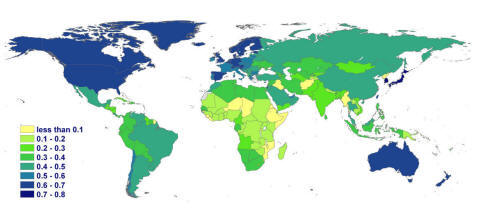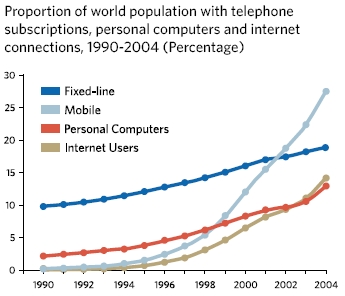By Ismael Peña-López (@ictlogist), 18 August 2006
Main categories: ICT4D
No Comments »
I recently found Donna Vaughan’s article ICT4D – Linking Policy to Community Outcomes . The article suggests moving from the macroeconomic approach of current ICT4D policies design to a more community based one. While the concept never appears in the text, what the author is actually demanding is a little bit of endogenous development stress in the Information and Communication Technologies for Development policies. She puts it this way:
We should move from this framework:
To this one:
While I mostly agree with her, and community, social capital and sustainability should be a must in every policy design, I understand she’s talking to change one model for the other, to shift from the current model to the alternative one. Well, this is where I disagree.
I fully believe that capacitation (i.e. digital literacy) and everything related to content and services should be community driven. Indeed, these two aspects should lead the whole ICT4D policy and projects. The question is that:
- Concerning ICT Infrastructures (hard, soft and connectivity) there’s so huge economy scales that endogenous development would very likely appear as inefficient
- Regarding regulation and the legal framework I believe that things will happen easier if the norm comes before that if the community has to pull the legal framework for a change
In between, the need of a strong (or sufficiently developed) ICT sector, which comes in between the ICT infrastructures policy and the regulation changes.
Thus, my oppinion is that regarding capacitation and uses, endogenous development is the option. For all the rest, the current approach is quite a good second best, provided is driven by capacity and uses, not per se, which is the key.
Don’t forget to have a look at the article’s bibliography: a very good choice.
By Ismael Peña-López (@ictlogist), 17 August 2006
Main categories: ICT4D
No Comments »
Created in june 2006, the United Nations Global Alliance For ICT And Development (UN-GAID) is the initiative to foster ICT4D from the UN but gathering all stakeholders involved.
In a nice article, Nalaka Gunawardene asks himself the same questions almost everybody does:
ICTs have to prove their worth, and be accepted as adding value to living and working conditions of people. […]Does the new technology or process:
- Put more food on our tables?
- Add more money in our pockets?
- Make interfacing with government easier?
- Save time and effort involved in commuting?
- Support cultural and personal needs of individuals and groups?
- Finally, is it affordable, user-friendly and widely available, with minimum entry level barriers?
I do hope so. We’ll see…
By Ismael Peña-López (@ictlogist), 07 August 2006
Main categories: Digital Divide, Digital Literacy, ICT4D
1 Comment »
We’re used to see the Digital Divide defined two ways:
- Have vs. have not, concerning the ownership of ICT tools — a materialistic or infrastructual approach
- Possibility of access, access to ICTs, including, sometimes, access to digital services and content — a broader approach, but still quite simple
A correct definition of digital development and e-readiness relies on an accurate definition of what digital divide is (all in all, the same thing). Forgeting what Digital Literacy is and implies is, usually, what lacks in all this concepts around the Digital Divide and a functiona empowerment of ICTs.
Here come two interesting references to add to the well known Mark Warschauer seminal articles:
Selwyn, N. (2004). “Reconsidering political and popular understandings of the digital divide”. In New Media & Society, Vol 6 (3), 341–362. London: SAGE Publications
The author starts with four main questions:
(1) what is meant by ICT;
(2) what is meant by ‘access’;
(3) what is the relationship between ‘access to ICT’ and ‘use of ICT’; and
(4) how can we best consider the consequences of engagement with ICT
and answers back proposing four categories of digital development or, as he calls it, stages in the Digital Divide:
(1) Formal/theoretical ‘access’ to ICTs and content
(2) Effective ‘access’ to ICTs and content
(3) Engagement with ICTs and content
(4) Outcomes – actual and perceived Immediate/short term consequences of ICT use. Consequences – actual and perceived
Selwyn is somehow based — it’s cited in his bibliography — in the following work:
Carvin, A. (2000). “More Than Just Access: Fitting Literacy and Content into the Digital Divide Equation”. In Educause Review, November/December 2000, 38-47. Boulder: Educause.
Where the author categorizes the different skills that allow the user to fully access and benefit from ICTs:
(1) Basic Literacy: Can I read and write?
(2) Functional Literacy: Can I put my reading and writing skills to daily use?
(3) Occupational Literacy: Do I know the basics of working in a business environment?
(4) Technological Literacy: Can I use common IT tools effectively?
(5) Information Literacy: Can I discern the quality of content?
(6) Adaptive Literacy: Can I develop new skills along the way?
In my point of view, while Basic Literacy is a must, it does not belong to Digital Literacy in a strict sense. On the other end of the classification, I’d add e-Awareness, as the ability to understand what’s happening in the world and how ICTs are changing it and, thus, how do I have to react to this. Maybe this concept is included in the Adaptive Literacy category, but I guess I’d add it as a 6th category (provided I’d didn’t include the first one, Basic Literacy).
Highly recommended reading both articles.
By Ismael Peña-López (@ictlogist), 17 July 2006
Main categories: Digital Divide, ICT4D
No Comments »
In the International Workshop “Towards a European Approach for Monitoring eInclusion” that took place last June 21st in Brussels — I wasn’t there, but the Internet was — Tobias Hüsing presented “The Digital Divide Index. Exploiting cross national survey data to quantify levels of e-exclusion”.
One of the most relevant aspects in his presentation is the birth (!?) of the eInclusion Index (eIIx). The index is also called “the Riga Index” in honour to the Ministerial Declaration on e-Inclusion signed on June 12th 2006 (not to be tanken for the Riga Declaration on the fight against money laundering). What this eIIx index will focus is in the groups in risk of e-exclusion. Thus, some of the variables from DiDix are taken apart to build this new eIIx and show what Riga is stressing. The problem is that a lot of data is missing as Riga definitions don’t exactly match those chosen by DiDix, thus the conclusion being that there’s a “need for analytical monitoring”, which I totally agree with.
More info:
By Ismael Peña-López (@ictlogist), 10 July 2006
Main categories: Connectivity, Digital Divide, e-Readiness, Hardware, ICT4D
No Comments »
New report developed by the International Telecommunication Union, the UNCTAD, the Ministry of Information and Communications of the Republic of Korea and the Agency for Digital Opportunity & Promotion (KADO).
This report charts progress towards the Information Society, in response to the call by the WSIS Geneva Plan of Action, for evaluation and international benchmarking, as well as the need for monitoring of WSIS follow-up and implementation (noted in the WSIS outcome documents). It evaluates access to telecommunications and digital opportunity in 180 economies worldwide in the context of the WSIS targets and Millennium Development Goals. It presents the Digital Opportunity Index, as called for by the WSIS Geneva Plan of Action, paragraph 28, and considers the policy implications for the further evolution of the Information Society. It reviews WSIS implementation and follow-up in different countries, and considers efforts to promote ICT development. It also presents the latest available data on 180 economies worldwide.
It is intended that the “The World Information Society Report” will be an annual publication.
So, it seems that the transition from the Digital Access Index and the Digital Opportunity Index has been done. Nevertheless, looking at who is backing the new report and, hence, the DOI, I guess there’s still some time until the Partnership on Measuring ICT for Development becomes really functional. I suppose it’s likely that next edition will be signed by the Partnership in its whole.

Digital Opportunity Index 2005. Source: World Information Society Report 2006
[click to enlarge]
The main two reflections that come to mind — besides the most evident about the digital divide and wealth distribution/opportunity-to-access in the world — are:
- There’s a urgent need to stablish an index covering the whole range of the digital divide and not just infrastructures: digital literacy, content and services use and policy, legal framework.
- Disturbing content and Diverted to bad sites stands for only 7% of the greatest online fears, being cibercrime (in its many faces) up to 91%. This makes me think about the unbalanced efforts made in censorship apps, filters and regulation by paternalist Governments in front of the real needs as perceived by users.
By Ismael Peña-López (@ictlogist), 05 July 2006
Main categories: Development, ICT4D
1 Comment »
The Millennium Development Goals Report 2006 has just been released and the main conclusion is “well… errrr… we’ve not accomplished almost anyhting… some things have indeed worsened… but, hey, let’s give a positive and optimist message that there’s some change to move into the right path”.
Concerning ICT’s and ICT4D it is evident that, actually, there’s an increasing adoption of these technologies at all levels:

Proportion of world population with telephone subscriptions, personal computers and internet connections, 1990-2004 (Percentage). Source: Millennium Development Goals Report 2006
But I’m “glad” to read that:
[there is] a large digital divide separating developed and developing
regions: Over half the population in developed regions had access to the Internet, compared to 7 per cent in developing regions and less than 1 per cent in the 50 least developed countries.
Of course I’m not “glad” to read that there is a digital divide, but that at least someone recognizes it exists and, regardless of the fact that in relative terms the divide has decreased, in practical terms it is so huuuuuuge that shame on you for sticking to righteous-and-oh-so-formally-correct statistical data interpretation. This is something I wrote about in my post World Telecommunication/ICT Development Report 2006: digital divide narrowing?
and feel comforted to see that I’m not the only one looking at it this way.


 Full article (340 Kb)
Full article (340 Kb)


